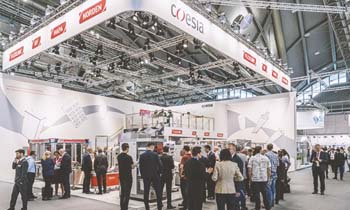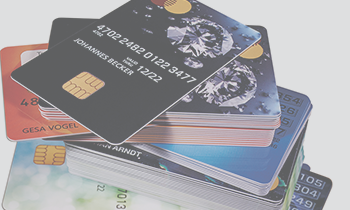Drop-on-demand inkjet vs. laser card personalization
A powerful marketing tool that should be used better
According to René Stoerk, Sales Director at Atlantic Zeiser, banks and personalization bureaus have recognized the great potential for credit and debit card personalization. This potential covers both design and the use of trendy or sustainable card materials.
Mr. Stoerk, you say that banks and personalization bureaus leave lots of opportunities on the table when it comes to debit card personalization. What makes you think so?
René Stoerk: Most bank cards, especially in Germany, are still personalized with laser marking technology. That is a proven method. But it has severe limitations with respect to design and efficiency. A conventional laser can produce neither white nor colors. That is a serious disadvantage for reproducing things like bank logos, or for white text on a dark background, for an especially elegant look. Banks in other countries are much more creative. That may be because they are completely free in their choice of personalization partner. So, they generally use drop-on-demand (DoD) technology, which is a special inkjet printing technology.
But aren’t there colored lasers as well?
There are. But they are extremely expensive to buy and to operate, and they are very slow. On top of that, they work only with special card materials, which means additional limitations on material selection. DoD technology, on the other hand, provides almost unlimited color options based on magenta, cyan, yellow, and black for a reasonable price. Despite the four-color technology, DoD is also much faster than laser technology. And it is especially good at printing on other materials besides the commonly-used PVC. Laser technology isn’t.
Why would you use a different card material?
There are two reasons. One is that bank and debit cards are a super marketing tool that banks should make better use of. Card owners signal a certain status, the card is a way for them to distinguish themselves. Think about gold and platinum cards that are playing an increasingly important part for customers. In the future, these cards will differ more strongly in the materials they are made of. For instance, cards made of metal, or with a metalized surface at least, make a very exclusive impression. Other countries are already making use of that effect.
You said that there are two reasons to use other materials. What is the other one?
Sustainability. Cards made of PVC are an environmental problem. Generally, PVC is easy to recycle. But there aren’t many return systems for it. So, after the cards have expired and been destroyed, the residue often winds up in the garbage. Of course, bank and debit cards are used much longer than gift cards, for instance. But given the prevalence of bank and debit cards, they make up quite a bit of waste just in Germany. There is increasing pressure on banks to actively tackle this problem and consider other materials besides plastic. And for materials besides PVC and polycarbonate, DoD technology’s versatility is unequaled for personalization.
What other materials might be used?
Think of cards that are made largely of ecologically friendly materials such as OPC or wood. They can quickly become status symbols for younger target groups who place great value on a climate-neutral lifestyle and sustainable consumption. We are already doing print tests on wooden cards and are very confident that DoD technology can perform just as well there as with various plastics or metal. The same is probably true of cards made of other sustainable materials such as grass fibers, sugar cane, or cardboard, all of which are being discussed or tried out.
What is DoD technology’s track record in the financial area?
DoD technology has been approved for card personalization with the biggest payment systems in the world since 2009. At first, it was just open-loop prepaid cards. But for about ten years, DoD has been used for the entire range of flat financial cards that are not embossed, including credit and debit cards. Atlantic Zeiser is a global pioneer in this area. Our systems have been used to personalize ID cards, driver’s licenses, and voting cards for more than 20 years. This is a technology that has proven to be effective in security-related applications in many countries.

René Stoerk, Sales Director at Atlantic Zeiser: "Banks and personalization bureaus have recognized the great potential for credit and debit card personalization. This potential covers both design and the use of trendy or sustainable card materials."






